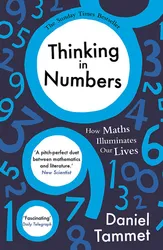This book contains a series of essays about the author’s experiences with numbers. Each essay is on a different topic, usually autobiographical from the author’s perspective, and relates to some area of mathematics. Certain concepts crop up in a few different chapters, such as the concept of infinity and the idea of multiple permutations. One chapter, for example, talks about the infinite variety of snowflakes. In another, the author talks about the possible permutations of the author and his eight siblings, and how the people in the town where he grew up might have perceived all the possible combinations of brothers and sisters that they might see at any one time.
Tammet has Asperger’s syndrome and also savant syndrome, meaning he has particularly special abilities. In the author’s case these abilities are in mathematics and memory. The author’s experience of mathematics is that it seems to permeate his perceptions of everything, and it was really interesting to view the world through this perspective while I was reading the book. He does a great job of describing his perceptions in a way that I could understand. Numbers seem to feel very alive to the author in a way that they probably don’t to most people. He has some interesting ideas about learning multiplication tables and solving algebra problems that might be useful to some people, but mostly it’s just a book to be enjoyed for the quality of the writing and the interesting perspective it gives you.
The maths doesn’t go particularly deep, so you won’t really learn much about the mathematics involved. Instead it offers a more poetic view, and relates mathematics to literature and art in interesting ways. One chapter is actually about poetry itself, describing the form of a sestina, which uses a mathematical formula to repeat the words that end lines in a particular pattern, and also talking about the haiku form. Another chapter talks about the possible alternative orderings of the scenes of a novel, in which a different story might be told from the same words.
My favourite chapter is the one in which the author attempts a record for reciting the digits of pi, in front of a live audience. It manages to be relatable, describing how the crowd reacts to this strange spectacle, and Tammet’s feelings as he completes the task, but also strange and perspective-shifting, as his synesthetic perceptions of the numbers set off peculiar trains of thought in his mind as he recites them.
The most science-focused chapter is probably the one about the Drake equation, Frank Drake’s attempt to estimate the number of extra-terrestrial civilizations that we might be able to detect in our galaxy. This is also one of the most conventional chapters in the book, with a fairly standard discussion of the factors and the inevitable uncertain conclusion to the question of “Are We Alone?“.
Some of the chapters resonated with me at a deep level, while others didn’t. But the book as a whole is easy and fun to read and will give you some new perspectives on familiar mathematical topics. I think most people will find this book charming and delightful to read, as long as they don’t expect the mathematics to be too significant.
